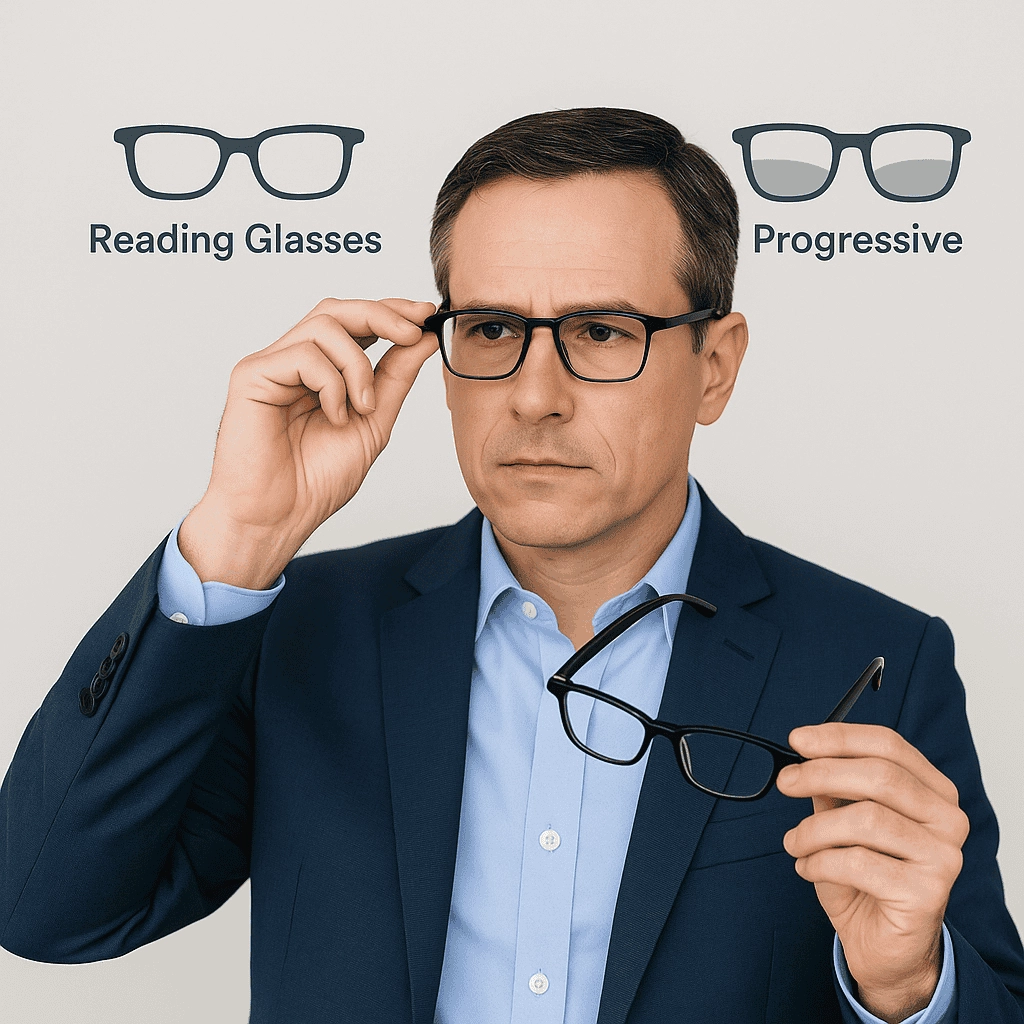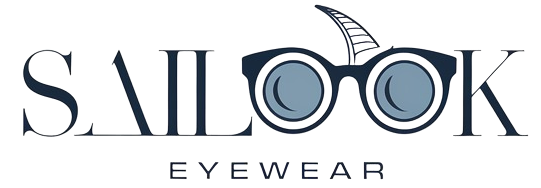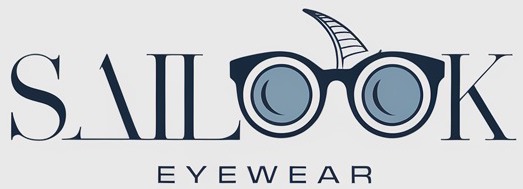Choosing between progressive and reading glasses can be overwhelming. Both offer solutions for improving vision, but they cater to different needs and lifestyles. In this article, we’ll break down the essential differences, explore the pros and cons of each, and help you determine which option is right for you. Whether you’re dealing with presbyopia or simply need extra help reading, understanding the benefits of each type of lens will ensure you make an informed choice. Let’s dive into the details.

1. What Are Progressive Glasses?
Progressive glasses, also known as progressive lenses, offer a multifocal solution, providing vision correction for distance, intermediate, and close-up viewing. These lenses are a great option for people who struggle with presbyopia, a condition that affects the ability to focus on nearby objects as we age. The key feature of progressive lenses is that they offer a seamless transition between different focal lengths without the visible lines that bifocals or trifocals have.
But here’s the kicker: Progressive lenses are not just for reading—they can be used for nearly all types of visual tasks, from driving to working on a computer, making them an excellent choice for people who need vision correction at all distances.
Key Features of Progressive Glasses
● Seamless transitions: Unlike bifocals, progressive lenses allow for a smooth transition between different distances without visible lines.
● Multi-zone functionality: Progressive glasses provide clarity for close-up, intermediate, and far distances, making them a versatile choice.
● Customizable options: You can select frames, lens coatings, and materials that suit your preferences and lifestyle.
Ready for the good part? Progressive lenses are great for people who are tired of switching between different pairs of glasses throughout the day. With just one pair, you can see clearly at all distances.
2. What Are Reading Glasses?
Reading glasses are a type of magnifying glasses specifically designed to help people with near vision problems, such as those caused by presbyopia. They are typically single-vision lenses, meaning they are optimized for reading or close-up tasks. Unlike progressive glasses, which offer a range of vision correction, reading glasses only magnify objects within a certain range, typically within arm’s reach.
Reading glasses are a simple and affordable solution for people who only need help with near-vision tasks. They come in a variety of strengths, allowing you to choose the one that works best for your level of difficulty in reading or doing detailed work.
What’s the real story? If you only struggle with near vision and don’t need correction for distance, reading glasses are a cost-effective and straightforward solution.
Benefits of Reading Glasses
● Affordable: Reading glasses are typically much cheaper than progressive lenses.
● Simple to use: They are easy to wear and only help with close-up tasks, making them ideal for reading and other detailed activities.
● Available in many strengths: You can select from a range of strengths depending on how severe your near vision problem is.
This is where it gets interesting: Despite their simplicity, reading glasses are often more than enough for people who don’t need vision correction for distance.
3. How Do Progressive Glasses Work?
Progressive glasses work by using a gradient of different lens powers to provide clear vision at varying distances. The top portion of the lens is used for distance vision, the middle section is for intermediate vision (such as for computer work), and the lower portion is for reading or close-up tasks. Unlike bifocals, which have a visible line separating the near and distance sections, progressive lenses offer a seamless transition between the different focal points.
What’s the catch? The main challenge with progressive lenses is the learning curve. Many new users need time to adjust to the different focal areas, especially when transitioning between close-up and far distances.
How Progressive Lenses Provide Clarity
● Top section: Used for distance vision (e.g., driving or watching TV).
● Middle section: Provides intermediate vision, ideal for using a computer or working in an office.
● Bottom section: Designed for close-up tasks like reading, knitting, or looking at a phone.
What’s the real story? Once you adjust to progressive lenses, they can provide more convenience than constantly switching between reading glasses and distance glasses.
4. How Do Reading Glasses Work?
Reading glasses are designed with a single vision lens that magnifies objects within a close range. Unlike progressive lenses, which transition between different focal lengths, reading glasses offer a fixed magnification, typically optimized for near-vision tasks such as reading, sewing, or working on crafts.
The lenses are generally designed with magnification powers that range from +1.00 to +3.00, depending on the severity of the wearer’s near vision problem. They are perfect for people who don’t need help with distance vision but require extra support when reading or performing detailed tasks.
Here’s the kicker: Reading glasses are easy to use—just slip them on when you need them, and remove them when you’re done. No adjustment period is needed.
Features of Reading Glasses
● Single-vision magnification: Focuses on near vision only, ideal for reading or other close-up tasks.
● Simple design: No need for complicated lenses or transitions—just clear magnification.
● Convenient: Easy to store, replace, and transport.
Ready for the good part? Reading glasses are the simplest and most affordable solution for people who need help with near vision tasks, without the complexity of progressive lenses.
5. Who Should Use Progressive Glasses?
Progressive glasses are ideal for people who experience presbyopia and need vision correction for all distances—near, intermediate, and far. People who engage in activities that require them to switch between reading, computer work, and driving will benefit from the versatility of progressive lenses. They provide a seamless transition between focal points, which is a game-changer for those who have to perform multiple tasks throughout the day.
But here’s the kicker: Progressive lenses are perfect for people who don’t want to wear multiple pairs of glasses. Instead of switching between reading glasses, distance glasses, and computer glasses, you can use one pair for all your needs.
Ideal Candidates for Progressive Glasses
● People with presbyopia: As we age, our near-vision deteriorates, and progressive glasses help manage this change.
● Multi-taskers: Ideal for people who need clear vision at various distances—whether for reading, working at a desk, or driving.
● Those seeking convenience: Progressive glasses provide a one-stop solution for all your vision needs.
This is where it gets interesting: If you’re tired of juggling multiple pairs of glasses, progressive lenses could be the answer you’re looking for.
6. Who Should Use Reading Glasses?
Reading glasses are perfect for people who only struggle with near vision. If you find it difficult to read small print or focus on objects close to you, reading glasses can offer an effective and affordable solution. These glasses are typically used by people who do not require vision correction for distance, making them an easy and straightforward choice.
What’s the catch? If you need help seeing things at both near and far distances, reading glasses may not be enough. In that case, you might want to consider progressive lenses.
Ideal Candidates for Reading Glasses
● People with presbyopia: Specifically for those whose near vision has worsened over time.
● Those who mainly read: If you primarily need help with reading books, newspapers, or phone screens, reading glasses may be your best option.
● Cost-conscious individuals: Reading glasses are generally cheaper than progressive lenses.
This is where it gets interesting: If you’re not looking for multi-distance correction, reading glasses are the most budget-friendly and practical solution for near-vision issues.
7. What Are the Key Differences Between Progressive and Reading Glasses?
When comparing progressive and reading glasses, the primary difference lies in their functionality. Progressive lenses are designed to provide vision correction for multiple distances—near, intermediate, and far—while reading glasses are only meant for close-up work. Progressive glasses are multifocal, offering seamless transitions between focal points, while reading glasses provide a fixed magnification.
But here’s the kicker: Progressive glasses are more versatile but come with a higher cost and learning curve. Reading glasses, on the other hand, are simple and affordable, but only help with close-up tasks.
Key Differences
| Feature | Progressive Glasses | Reading Glasses |
|---|---|---|
| Functionality | Multi-distance correction | Near-vision correction only |
| Design | Seamless transition between zones | Single magnification lens |
| Ideal For | Multi-taskers, presbyopia sufferers | People who only need near-vision help |
| Cost | More expensive | Affordable |
What’s the real story? If you need clear vision at multiple distances, progressive lenses are the way to go. If you only need help with close-up tasks, reading glasses will do the trick.
8. When Should You Choose Progressive Glasses Over Reading Glasses?
Progressive glasses are the ideal choice if you need vision correction for multiple distances. Whether you’re driving, working at a computer, or reading a book, progressive lenses provide a comprehensive solution for all your visual needs.
What’s the catch? Progressive lenses may take some time to adjust to, and they come with a higher price tag compared to reading glasses.
Reasons to Choose Progressive Glasses
● All-in-one solution: Progressive lenses eliminate the need for multiple pairs of glasses.
● Multi-tasking capabilities: Ideal for people who need clarity at varying distances.
● Long-term convenience: Once you adjust, progressive lenses offer unmatched convenience.
Ready for the good part? If you’re tired of constantly switching between glasses, progressive lenses offer a seamless transition between near, intermediate, and far vision.
9. When Should You Choose Reading Glasses Over Progressive Glasses?
If your vision problems are limited to near vision only and you don’t need help seeing things at a distance, reading glasses are the ideal solution. They’re affordable, easy to use, and effective for close-up tasks. Reading glasses are perfect for people who only need magnification to read books, newspapers, or work on detailed tasks.
Here’s the kicker: If you don’t need multifocal correction, reading glasses are a simple and cost-effective way to improve your close-up vision.
Reasons to Choose Reading Glasses
● Affordable: Reading glasses are much cheaper than progressive lenses.
● Simplicity: No need to worry about adjusting to different focal points.
● Best for near-vision issues: If you only need magnification for close-up work, reading glasses are the perfect choice.
What’s the real story? If you only need help with reading and close-up tasks, reading glasses are the way to go.
10. How Do Progressive Glasses Compare to Bifocals?
Bifocal glasses are similar to progressive glasses in that they help with near and far vision. However, the key difference is that bifocals have a visible line between the two focal areas, while progressive lenses offer a seamless transition.
What’s the real story? Progressive lenses offer a more modern, stylish solution than bifocals, with no visible lines separating the two zones.
Bifocals vs Progressives Comparison
| Feature | Bifocals | Progressive Glasses |
|---|---|---|
| Focal Points | Two distinct zones (near and far) | Smooth transition between near, intermediate, and far |
| Aesthetic | Visible line between zones | No visible line, seamless design |
| Ideal For | Near and distance vision correction | Multi-distance vision correction |
But here’s the kicker: If you want a more stylish, seamless solution, progressive lenses are the better choice.
11. Can You Wear Progressive Glasses for Both Near and Far Vision?
Yes, progressive glasses are designed to provide clear vision at near, intermediate, and far distances. The lenses transition smoothly from one focal point to the next, making them ideal for people who need help with both near and distance tasks.
What’s the catch? It may take some time to adjust to the different focal zones.
Progressive Lenses for Near and Far Vision
● Top section: Ideal for distance vision (e.g., driving, watching TV).
● Middle section: Designed for intermediate tasks like using a computer.
● Bottom section: Perfect for close-up tasks such as reading.
This is where it gets interesting: Progressive lenses are a one-stop solution for people who need vision correction at multiple distances.
12. Are Reading Glasses Better for People with Presbyopia?
Reading glasses are a great option for people with presbyopia, a condition that makes it harder to focus on close-up objects. They are simple, affordable, and effective for reading, sewing, or doing other detailed tasks. However, reading glasses only work for near vision and won’t correct distance vision.
What’s the real story? If you only need help seeing close-up, reading glasses are the perfect solution for presbyopia.
Reading Glasses for Presbyopia
● Affordable: Ideal for people with presbyopia who only need help with near vision.
● Simple: No adjustments required, just magnification for close-up tasks.
● Limitations: Don’t address distance vision issues.
Ready for the good part? If you only need help with reading or close-up work, reading glasses are an effective and budget-friendly solution.
13. What Is the Cost Difference Between Progressive and Reading Glasses?
The cost of progressive glasses is typically higher than reading glasses due to their multifocal nature and the technology behind them. Progressive lenses require precise measurements and customized fitting, which increases their cost. Reading glasses, on the other hand, are more affordable since they are single-vision lenses.
What’s the catch? While progressive lenses are more expensive, they offer greater convenience by providing vision correction for all distances.
Cost Comparison Between Progressive and Reading Glasses
| Feature | Progressive Glasses | Reading Glasses |
|---|---|---|
| Cost | More expensive | More affordable |
| Customization | Requires measurements and fitting | Ready-made or basic options |
| Functionality | Multi-distance vision correction | Near-vision correction only |
This is where it gets interesting: If budget is a concern, reading glasses offer a cost-effective solution. But if you need a versatile option for all your vision needs, progressive lenses are worth the investment.
14. How Can You Choose the Right Type of Glasses for Your Lifestyle?
Choosing the right type of glasses depends on your lifestyle and vision needs. If you need correction for multiple distances, progressive glasses offer the convenience of all-in-one lenses. However, if you only need help with close-up tasks, reading glasses are a simpler, more affordable choice.
But here’s the kicker: Think about your daily routine and which tasks require visual aid. Are you constantly switching between reading glasses and distance glasses? If so, progressive lenses may save you time and hassle.
Choosing the Right Glasses
● For multi-taskers: Progressive lenses provide an all-in-one solution for varying distances.
● For readers: If you primarily need help reading, reading glasses will suffice.
● For convenience seekers: Progressive lenses eliminate the need for multiple pairs of glasses.
Ready for the good part? Understanding your vision needs will help you make an informed decision.
15. How to Care for and Maintain Your Progressive or Reading Glasses?
To keep your glasses in top condition, it’s essential to clean and store them properly. Use a microfiber cloth to wipe your lenses and avoid using paper towels, which can scratch the lenses. Store your glasses in a protective case when not in use to prevent damage.
What’s the catch? With progressive lenses, it’s important to make sure the fit is correct, as improper fitting can lead to discomfort and blurred vision.
Glasses Care Tips
● Cleaning: Use a microfiber cloth to avoid scratches.
● Storage: Keep glasses in a protective case when not in use.
● Fit: Ensure progressive lenses are properly fitted to avoid discomfort.
This is where it gets interesting: Proper care and maintenance will help prolong the life of your glasses, ensuring clear vision for years to come.
Conclusion
Choosing between progressive and reading glasses depends on your specific vision needs. If you require vision correction for both near and far distances, progressive lenses are an excellent all-in-one solution. However, if you only need help with close-up tasks, reading glasses offer a simple, affordable option. Ultimately, the right choice for you will depend on your lifestyle, tasks, and budget.
What’s the real story? By understanding your vision needs, you can select the best glasses that will keep you seeing clearly at all distances.
FAQ Section
Q1: What is the difference between progressive and reading glasses?
Progressive glasses provide correction for near, intermediate, and distance vision, while reading glasses only help with near vision tasks.
Q2: How do progressive lenses work?
Progressive lenses provide a smooth transition between different focal points, allowing users to see clearly at multiple distances without visible lines.
Q3: Can you use progressive lenses for reading?
Yes, progressive lenses are ideal for reading, as they provide a dedicated zone for close-up tasks.
Q4: Are reading glasses suitable for people with presbyopia?
Yes, reading glasses are designed for people with presbyopia, providing magnification for near vision tasks like reading.
Q5: How do I choose between progressive and reading glasses?
If you need vision correction for multiple distances, progressive lenses are ideal. If you only need help with reading or close-up tasks, reading glasses will be sufficient.

